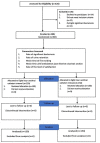Eight-hour versus 24-h urethral catheter removal following elective caesarean section for reducing significant bacteriuria: A randomized controlled trial
- PMID: 34812114
- PMCID: PMC8628312
- DOI: 10.1177/17455065211060637
Eight-hour versus 24-h urethral catheter removal following elective caesarean section for reducing significant bacteriuria: A randomized controlled trial
Abstract
Background: There is no consensus on the preferred time to remove urethral catheter post caesarean section.
Aim: To compare rate of significant bacteriuria and urinary retention following 8-h (study) and 24-h urethral catheter removal (control) post elective caesarean section.
Methods: A randomized controlled trial of eligible participants that underwent elective caesarean section under spinal anaesthesia between March 2019 and November 2019 was conducted. Participants (150 in each arm) were randomly assigned (1:1 ratio) to either 8-h or 24-h group. Primary outcome measures included rates of significant bacteriuria 48-h post-operatively and acute urine retention 6-h post urethral catheter removal. Analysis was by Intention-to-treat. (www.pactr.org:PACTR202105874744483).
Results: There were 150 participants randomized into each arm and data collection was complete. Significant bacteriuria was less in 8-h group (3% versus 6.0%; risk ratio (RR): 0.85 CI: 0.60 to 5.66; p = 0.274), though not significant. Acute urinary retention requiring repeat catheterisation was significantly higher in 8-h group (11(7.3%) versus 0(0.0%); RR: 0.07; CI: 0.87 to 0.97; p = 0.001). Mean time until first voiding was slightly higher in 8-h group (211.4 ± 14.3 min versus 190.0 ± 18.3 min; mean difference (MD): 21.36; CI: -24.36 to 67.08; p = 0.203); but patient in this group had a lower mean time until ambulation (770.0 ± 26.1 min versus 809 ± 26.2 min; MD: -38.8; CI: -111.6 to 34.0; p = 0.300). The 8-h group were significantly more satisfied (82/150 (54.7%) versus 54/150 (36.0%); p = 0.001).
Conclusions: An 8-h group was associated with significant clinical satisfaction and acute urine retention compared to 24-h removal. The timing of urethral catheter removal did not affect rate of significant bacteriuria and other outcomes.
Keywords: acute urine retention; caesarean section; hospital stay; post-operative satisfaction; urethral catheter removal.
Conflict of interest statement
Similar articles
-
A randomized controlled trial of 12 hours versus 24 hours urinary catheter removal following uncomplicated caesarean section in Ekiti State, Nigeria.Afr J Reprod Health. 2023 Jun;27(6s):44-50. doi: 10.29063/ajrh2023/v27i6s.6. Afr J Reprod Health. 2023. PMID: 37694701 Clinical Trial.
-
Early versus delayed removal of indwelling catheters in patients after elective cesarean section: a prospective randomized trial.J Matern Fetal Neonatal Med. 2020 Jan;33(1):68-72. doi: 10.1080/14767058.2018.1487394. Epub 2018 Jul 18. J Matern Fetal Neonatal Med. 2020. PMID: 29886771 Clinical Trial.
-
Early versus delayed removal of indwelling urinary catheter after elective cesarean delivery: systematic review and meta-analysis of randomized controlled trials.J Matern Fetal Neonatal Med. 2020 Aug;33(16):2818-2825. doi: 10.1080/14767058.2018.1557142. Epub 2019 Jan 7. J Matern Fetal Neonatal Med. 2020. PMID: 30522371
-
[Bacteriuria and Symptomatic Urinary Tract Infections during Antimicrobial Prophylaxis in Patients with Short-Term Urinary Catheters - Prospective Randomised Study in Patients after Joint Replacement Surgery].Acta Chir Orthop Traumatol Cech. 2017;84(5):368-371. Acta Chir Orthop Traumatol Cech. 2017. PMID: 29351538 Clinical Trial. Czech.
-
Types of urethral catheters for management of short-term voiding problems in hospitalized adults: a short version Cochrane review.Neurourol Urodyn. 2008;27(8):738-46. doi: 10.1002/nau.20645. Neurourol Urodyn. 2008. PMID: 18951451 Review.
Cited by
-
Efficacy and safety of different doses of epidural morphine coadministered with low-concentration ropivacaine after cesarean section: A retrospective cohort study.Front Pharmacol. 2023 Apr 6;14:1126174. doi: 10.3389/fphar.2023.1126174. eCollection 2023. Front Pharmacol. 2023. PMID: 37089946 Free PMC article.
-
Description of Postoperative Void Patterns After Scheduled Cesarean Delivery Without Use of Routine Intraoperative Urinary Catheterization in a Large-Volume Safety Net Hospital.Cureus. 2025 Aug 2;17(8):e89260. doi: 10.7759/cureus.89260. eCollection 2025 Aug. Cureus. 2025. PMID: 40904954 Free PMC article.
-
The research frontier of cesarean section recovery: A bibliometric analysis.Front Med (Lausanne). 2022 Dec 13;9:1071707. doi: 10.3389/fmed.2022.1071707. eCollection 2022. Front Med (Lausanne). 2022. PMID: 36582295 Free PMC article.
References
-
- Onyegbule OA, Udigwe GO, Ezebialu I, et al.. Catheter-associated urinary tract infection following caesarean section in Nnewi, Nigeria: a prospective comparative study. Br Microbiol Res J 2014; 4(9): 1025–1034.
-
- Ajenifuja KO, Oyetunji IO, Orji EO, et al.. Postpartum urinary retention in a teaching hospital in southwestern Nigeria. Gynaecol Obstet Res 2013; 39(8): 1308–1313. - PubMed
-
- Chowdhury L, Jahan I. Cesarean section without urethral catheterization. J Armed Forces Med Coll Bangladesh 2016; 11(1): 3–6.
-
- Li L, Wen J, Wang L, et al.. Is routine indwelling catheterisation of the bladder for Caesarean section necessary? A systematic review. BJOG 2011; 118(4): 400–409. - PubMed
Publication types
MeSH terms
LinkOut - more resources
Full Text Sources


